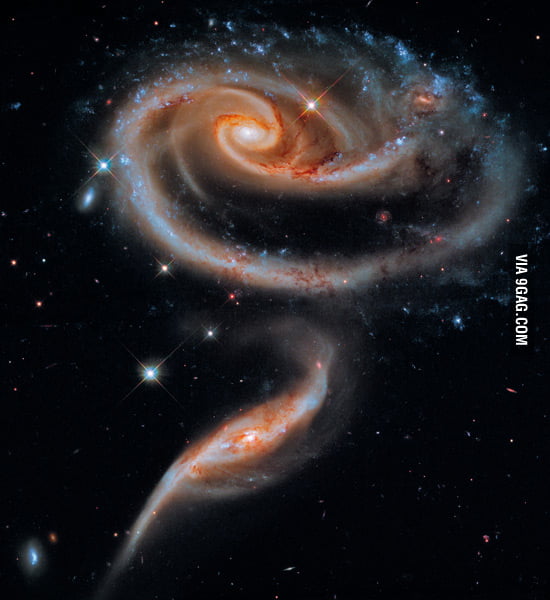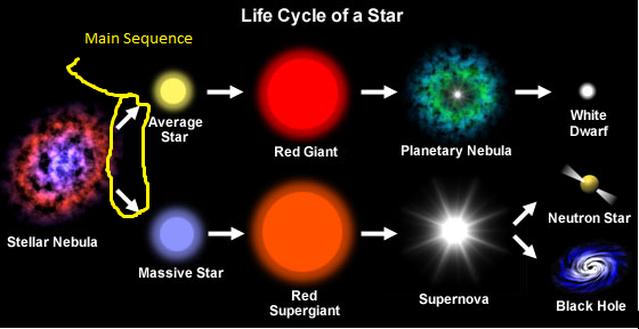RocketRon wrote:APOD Robot wrote:This ring's blue color is caused by massive stars that are
blue hot
Very scenic.
Is there any good discussion anywhere about WHY stars 'burn' at different temperatures.
For stars on the main sequence, the color of the star depends (almost) entirely on its mass.
Main sequence stars shine by fusing hydrogen to helium in their cores. When the star has used up the hydrogen in its core it will turn into a giant, and although most stars will spend all of their lifetimes as giants as red stars, some stars will "turn blue again", like
blue horizontal branch stars and some blue supergiants. For example, the progenitor of supernova 1987A was Sanduleak −69° 202, a blue supergiant. It is believed that Sanduleak −69° 202 had evolved into a red supergiant after leaving the main sequence, and then it shed quite a lot of its mass and turned into a blue supergiant. As a rule of thumb, evolved stars that shine with a blue light are smaller than evolved stars that shine with a red or yellow light. Note that this does not apply to degenerate stars like
white dwarfs.
Look at the star cluster at left, M44 in Cancer. According to
Wikipedia, the age of M44 is 600-700 million years. Again according to Wikipedia, M44 contains red giants and white dwarfs, as well as main sequence stars of spectral classes A, F, G, K, and M.
Again take a look at the picture. The bright yellow stars in the picture are red giants of spectral class K. Their temperature is about 4,000K or a little more, but not as high as 5,000K. The bright blue stars are main sequence stars of spectral class A. Their temperature is about 8,000-9,000K. If we consider the photospheres of the stars to be their "surfaces", then each "square mile" or "square kilometer" of the surface of the main sequence A-type stars shines brighter than each square mile or square kilometer of the red giants stars. But because the red giant stars are bigger, their surfaces have many more square miles or square kilometers than the main sequence A-typs stars. As a consequence, both types of stars shine about equally bright in this cluster.
Incidentally, the red giants are every bit as hot in their centers as the A-type main sequence stars. Actually, the centers of the red giants are even hotter - sometimes many times hotter - than the centers of the main sequence A-type stars. But precisely because the red giants are so big and "swollen", their atmospheres have a reddening effect on the highly energetic photons being generated in fusion processes in their centers. These photons have to "fight their way through so much fog", and undergo so many energy-stealing collisions with protons inside the star before they reach the photosphere where they can escape, that most of them leave the star as relatively low-energy photons which emit red, orange or yellow light.
But let's return to the main sequence stars, which are easier to understand. For each such star, its color is dependent on its mass. The higher the mass, the faster and more intensely the hydrogen fusion in the center of the star must proceed in order to counteract the strong gravity that presses inward on the centers of these stars. Very many high-energy photons are created in their very hot centers, and although blue main sequence stars are bigger than, say, the Sun, they are still small enough to let many high-energy photons escape from their photospheres.
Consider the brightest-looking star in the sky, Sirius. Sirius is a main sequence A-type star, not unlike the brightest blue stars in M44. It is almost exactly twice as massive as the Sun, but it is almost 23 times brighter and considerably bluer and a lot more ultraviolet than the Sun. It is the extra mass of Sirius that forces its hydrogen fusion in its center to work so fast and so intensely. By contrast, in the case of small light-weight red main sequence stars, their hydrogen fusion works very slowly, producing relatively few photons of rather low energy, and the photons that leave the photospheres of the small red stars are typically low-energy photons corresponding to red, orange and yellow light.
Stars are
blackbodies, producing light as blackbodies of a certain temperature. For every temperature, there is a blackbody curve that peaks at exactly that temperature. Blueward of the peak, the curve dips down relatively quickly, but redward of the peak the curve rises rather slowly. What this means is that a sufficiently cool star may not produce any blue light at all, or hardly any blue light, because its blackbody curve dips down to almost zero before it reaches the region of blue light. By contrast, a very hot star will always produce green, yellow, orange and red light as well as blue and ultraviolet light, because its blackbody curve is far from zero as it passes through these colors.
Finally, you might want to consider the picture at left, showing the evolution of stars of different masses. Perhaps you would also like to visit the page that I have linked to below the picture.
Ann
 UGC 1810: Wildly Interacting Galaxy from Hubble
UGC 1810: Wildly Interacting Galaxy from Hubble




